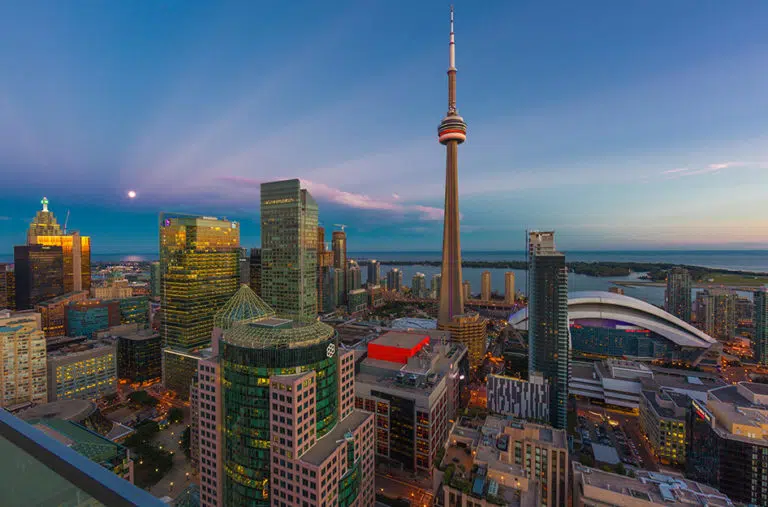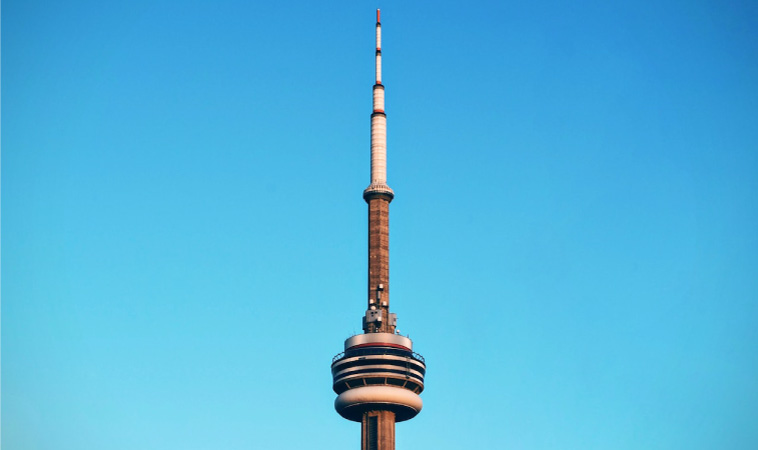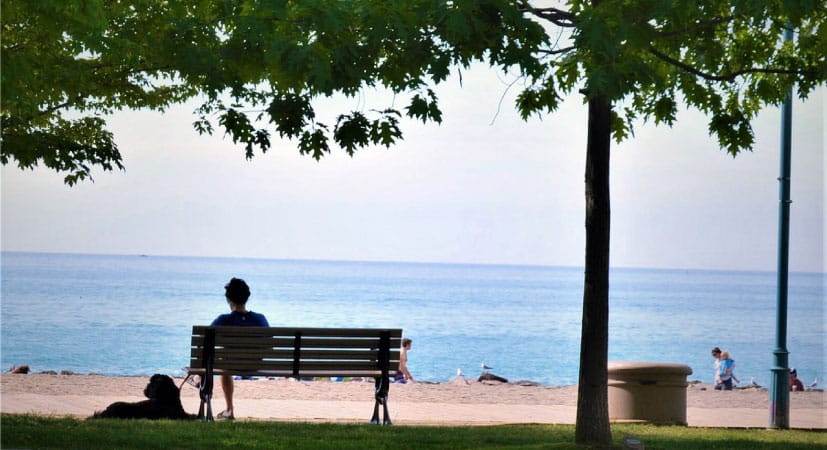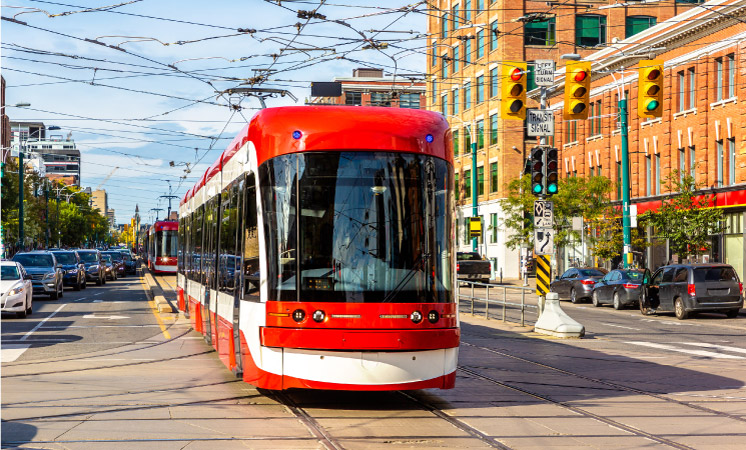
Life in Toronto: What You Need To Know
Toronto Canada
Are you thinking about joining them and moving to Toronto yourself? Here are a few things we think you should know.
Toronto, ON, at a Glance
- With over 3 million residents, the city of Toronto is the most populous in Canada and, perhaps surprisingly (after Mexico City, New York, Los Angeles, and Chicago), the fifth largest city in North America.
- Toronto is a powerful business centre with a burgeoning tech industry.
- With over 50 percent of its population foreign-born, it’s one of the most diverse cities in the world.
- Many parts of the city have a young and hip vibe, as millennials are now the dominant age group in the centre core.
- The winters can be harsh but not nearly as cold and snowy as other Canadian cities (excluding Vancouver). The average high temperature is -1 degree Celsius in January, while the average snowfall is 3.3 inches. The summers are generally pleasant — with an average temperature above 20 degrees Celsius — but it can be hot and humid in July and August.
- The median sale price for single detached homes was $1,250,000 in the third quarter of 2023, which is about 4.2% higher than last year.
- Toronto is considered a moderately safe city with a crime index of 42.92. This compares to 74.62 for Baltimore (the higher the number, the higher the crime level), which is considered one of the least safest cities in the U.S.
1. Life in Toronto, ON
Every city comes with its pros and cons, right? Toronto’s no different. However, it’s clear to us that the positives outweigh any negatives. Here’s a high-level list of some advantages and disadvantages. Check ‘em out and decide for yourself if there are any deal breakers (Hint: You’ll likely find the same disadvantages in any other large city).
What Are the Advantages of Living in Toronto?
- High standard of living
- Strong and diverse job market
- Very safe for a big city
- Excellent hospitals and healthcare system
- Efficient transit system
- World-class entertainment
- Very diverse culture
- Great and plentiful restaurants
- Lots of parks and trails
- Highly rated schools and post-secondary institutions
What Are the Disadvantages of Living in Toronto?
- High cost of living
- Traffic congestion
- Long commute times
- Sparse and expensive city centre parking
- Crowded city centre — especially in the subway during rush hours
- Cold winters, humid summers
- Pricey homes
- Increasingly expensive apartment rental prices
- Non-stop construction
- Difficult job market for some immigrants
Q: Is Toronto a good place to live in?
A: Toronto as a city is great. With a diverse dining scene, many different cultures represented, plenty of things to do every weekend, and easy access to everything through the TTC, living an urban lifestyle is easy to accomplish.

2. Cost of Living in Toronto
Okay, so life in Toronto isn’t cheap — with a cost of living ranked as one of the highest in Canada — but it’s still nearly 29 percent lower than New York City, for perspective. And the average cost of a home in Toronto, while still pricey at around $1.2 million, has been on the decline. As home buyers currently sit on the sidelines, the average one-bedroom apartment and condo rental price, however, has risen more than 13 percent year over year.
Q: What salary do you need to live comfortably in Toronto?
A: According to Numbeo, the average monthly net salary in Toronto is 4,769.03C$. However, estimated monthly costs for an individual are 1,539.30C$, not including rent. If you consider the average monthly rent for a one-bedroom apartment outside of centre is 2,315.67C$, you could conceivably live comfortably on a salary of around 92,500.00C$, if you’re looking to live alone and follow the “30 percent rule.”
3. Best Neighbourhoods in Toronto
Now onto the really good stuff! There are plenty of great neighbourhoods in the city of Toronto to consider. Which one you choose while living in Toronto City may simply come down to affordability and how close it is to where you’ll be working, studying, or spending most of your time. Here are our recommendations — with some alternatives, as well — for families, students, professionals, and retirees.
Best Toronto Neighbourhoods for Families
Homes in Riverdale tend to be priced on the higher side, but when it comes to living in this community, you get what you pay for. Young families are attracted to its highly rated elementary schools, like Withrow, Frankland, and Montcrest; its two vast parks (Withrow and Riverdale); and great shopping and restaurants on the Danforth (aka “Greektown”). You also have easy access to the city centre and the Don Valley Parkway, which is Toronto’s primary north/south highway.
Other family-friendly neighbourhoods to consider are Leaside, Leslieville, Lawrence Park South, and Bloor West Village.

Best Toronto Neighbourhoods for Students
If you are a student at one of the centre universities or colleges (University of Toronto, Ryerson University, George Brown College, OCAD) and the Annex area is outside of your budget, you might consider Dufferin Grove. Rentals are more reasonably priced there, and you’ll be between College St. (the southern border of U of T) and the Bloor St. subway line. You’ll also be close to Little Italy on College St., hip Queen St. W., and Trinity Bellwoods Park, where the younger folk come to play. It’s also bounded on the east with trendy bars and restaurants on Ossington Ave.
Students may also want to check out these other areas: The Annex, Kensington Market, and the Garden District.
Toronto Neighbourhoods for Professionals
Yonge and Eglinton (once known as “Young and Eligible”) is just north of the centre core and has all the key attributes necessary to attract young professionals. The neighbourhood has a plethora of new condo options, but there are also plenty of detached homes on the leafy residential streets surrounding the primary intersection. You’ll have easy access to most city centre workplaces via the Eglinton subway station, which is only a 20-minute ride to Union Station. Parks and recreation areas are scattered about, and there is no shortage of grocery shopping, restaurants, and lively nightlife.
These alternative spots are also worth exploring: Bay St. Corridor, Leslieville, and Liberty Village.
Toronto Neighbourhoods for Retirees
While there are many neighbourhoods in the centre and midtown sections of the city that are very suitable for retirees, we recommend Bayview Village. It’s a bit northerly, but because it is bounded to the south by Highway 401 with the Don Valley Parkway not far to the east, you have easy access to all parts of the city. And if you prefer not to drive, the Bayview subway station (on the Sheppard line) is conveniently located at the main intersection.
The crown jewel of the neighbourhood is the upscale Bayview Village Mall, which has every amenity anyone would need — from grocery shopping, restaurants, and LCBO (Liquor Control Board of Ontario) to medical and dental offices. The mall is surrounded by well-appointed condominiums as well as beautifully maintained properties with all types of detached homes. There is also a YMCA right across the street from the mall.
Here are some other neighbourhoods that might fit the bill: Humber Valley Village, Casa Loma, and The Beaches.

The 360 Restaurant at the top of the CN Tower.
(Source: Tim Gouw via Pexels)
4. Things To Do in Toronto
Visitors to Toronto would have a hard time squeezing in all the amazing things to do and see, even if they were to stay an entire week. But if you plan to enjoy life in Toronto as a permanent resident, you’ll have plenty of time to space it out. Whether you’re a couple, on your own, or carting along a young family, you will have no problem keeping occupied with the lengthy list of activities available to you in the city of Toronto.
Anyone new to the city would likely start their life in Toronto by visiting the CN Tower (which stands a proud 553.33 metres tall). Enjoy lunch or dinner at the 360 Restaurant, see the views, and — for the most daring — try out the Edge Walk. Ripley’s Aquarium is one of the newer attractions just a few steps away. And foodies can venture a bit east along Front St. and enjoy the St. Lawrence Market, which has been the hub for food vendors since 1803.
For sports fans in Toronto, there is no off-season. The Toronto Blue Jays of MLB are the primary occupants of the Rogers Centre from April until (hopefully) late October. And as the ball season comes to an end, Scotiabank Arena begins to play host to the ever-popular Toronto Maple Leafs and the Toronto Raptors. Tickets tend to be hard to come by, but there’s always a way (or a guy). BMO Field is also the home to both Toronto FC of the MLS and the venerable Toronto Argonauts of the Canadian Football League. Although gaining in popularity, tickets at BMO are more easily attainable and more reasonably priced.
The arts are well-represented, as well, with the Canadian Opera Company theatre, Roy Thomson Hall, and several centre theatres, including the Ed Mirvish, Royal Alexandra, and the Elgin and Winter Garden theatres. And museum and art lovers will have their fill with the ROM (Royal Ontario Museum), AGO (Art Gallery of Ontario), The Bata Shoe museum, and the Hockey Hall of Fame, among many others.

Kew-Balmy Beach in Toronto
(Source: SilvavliS878 via Pixabay)
Free Things To Do in Toronto
Looking to save a buck or two? Check out these freebies to take advantage of in the Toronto area:
- The AGO (Art Gallery of Ontario) offers free admission every Wednesday evening and anytime for anyone 25 and under.
- Stroll through the 399-acre High Park in the west end of the city.
- Enjoy the historic Distillery District.
- Take the kids to the free zoo at Riverdale Farm in Cabbagetown.
- Walk, bike, or swim in the beaches along Lake Ontario.
- Hike or bike the Tommy Thompson waterfront trails.
- Graze the delicious free samples at St. Lawrence Market.
- Check out the free lunchtime concert series at the Canadian Opera Company Theatre.
- Window shop in Yorkville.
- Explore the 30-kilometre underground PATH pedestrian walkway.
- Go bohemian for the day in Kensington Market.
- Take a selfie with the TORONTO sign at Nathan Phillips Square.
- Take the scenic Philosopher’s Walk through the University of Toronto campus.
Toronto Nightlife
When it comes to fun things to do in Toronto for young adults, to paraphrase the Horace Greeley quote, “Go west, young men and women.” In other words, most of the hottest hotspots are located on the western side of the city.
Let’s start with King St. West. There are several established restaurants and bars that were originally part of the theatre district, but just a little ways west, the old buildings that housed textile manufacturing and warehouses have been revitalized into upscale lounges and nightclubs. Some of the most popular venues include Regulars, Arcane, EFS, and Lavalle (complete with a rooftop pool).
Back in 2014, Vogue magazine called Queen St. West the 2nd hippest district in the world. And the street has continued to evolve into a great place for a long daytime stroll and an exciting area to explore after dark. The street is loaded with a variety of watering holes, from the dives to the boutiques. Check out The Drake and Gladstone boutique hotels, The Bovine Sex Club (it’s not what you think), Horseshoe Tavern, and Drake Underground.
Another western area that, in the 1980s, was a grimey street with rundown homes, used car lots, and car repair shops but that has become one of the hippest streets in the city is Ossington Avenue. In fact, it now has some of the most popular restaurants and bars in the city. Painted Lady, Reposado, and Dakota Tavern are just a few of the establishments worth visiting.
The Church and Wellesley area of Toronto is known as The Gay Village. For the LGBTQ+ community, it is the place to eat, drink, and party. It’s also considered “ground zero” for the annual Pride Parade — one of the largest pride events in the world. Woody’s and its sister bar Sailor are the most established and raucous bars on the strip. Other venues include The Lodge and Church St. Garage.
The Annex, Little Italy, Parkdale, and Dundas St. West are additional nightspot districts to add to your list.

5. Getting Around the City
The TTC (Toronto Transit Commission, if you’re interested) has three main modes of transportation — subway, street car, and bus. All three are great options for getting around the city, especially if you don’t want to drive around the city centre or in the suburbs. Even if you’re not a fan of transit, walking or biking is possible in most places (though we might not recommend it when the streets are icy).
You can also take advantage of rideshare options, but it might cost you — especially if you’re a frequent traveler. You can expect to pay anywhere from 50C$ to 70C$ for an Uber to the airport, while the subway is only 3.35C$ for the average adult. You can also purchase a day pass for 13.50C$ or reload your Presto card, as needed. Some transit options in the city have recently rolled tap-to-pay, where you can use your phone to board your train, but we’d still recommend having a Presto card on hand. They’re easy to reload at most subway stations, and they’re a lot more reliable than other payment methods.
The only setback with transit is potential delays. Whether it’s an incident on the subway or rush-hour traffic while taking the bus home, it’s best to plan for things to happen and leave early when you can (adding an additional 30 minutes is always a good idea).
6. Is Toronto, Canada, a Good Place To Live?
Without a doubt. Whether you want to grab food at one of the tavernas in Greektown or head over to Koreatown for a night of drinking and karaoke, you’ll be able to experience all kinds of culture in Toronto. There are even six separate Chinatowns (aptly-named the Chinatown Sextet), all with their own distinct flair. Little Italy comes with plenty of food options, as well, and it’s not far from Kensington, so grabbing lunch at Cafe Diplomatico and heading over to the shops is never a bad idea.Toronto also comes with a crime rate of almost 43, while New York City sits at 50. It sits well under London and is almost tied with Berlin for safety ratings, but that doesn’t mean you’re ever at high risk.
Toronto is a bustling centre, as well, with plenty of people walking around both day and night. The best part? Residents are nice, and you’ll almost always be able to strike up a conversation with someone around you. You can feel safe knowing that you’re not alone, both in the city and in your identity.
Is Vancouver Better?
You might find yourself debating between Vancouver and Toronto, but which is actually better? Really, the answer depends on your individual situation.You’ll dole out more each month to live in the west coast city of Vancouver. According to Numbeo’s Cost of Living Plus Rent Index, you would need around 8,800C$ in Vancouver to maintain a similar lifestyle with just over 8,200C$ in Toronto. The general cost of things like rent, groceries, and consumer prices are all lower in Toronto, and you’ll have a 14.6 percent higher local purchasing power.
Both cities come with great dining scenes, though, along with their fair share of attractions to visit throughout the year. Vancouver comes with more beaches and fish to see, while Toronto has plenty of green space and wildlife to spot throughout the year.
Q: What do I need to know before moving to Toronto?
A: If you’re coming from a warm climate, be sure to stock up on thermals and get a good winter coat. Waterproof shoes for every season are a must, and make sure they’re comfortable enough to walk around in. Be prepared to hear different languages everywhere you go, as well, and always remember your Presto card. Aside from that, Toronto is similar to a lot of other cities in North America. In fact, you’ll likely hear it called a “cleaner version of New York City,” and that’s not far from the truth.

7. Is It Worth Moving to Toronto?
There’s no escaping the fact that a big city like Toronto has a certain energy that can’t be replicated in a small town or suburban area. So, yes, it’s expensive to live here, it can be busy and crowded at times, and traffic congestion is always an issue. But if you want to live in a vibrant, exciting city with low crime and top-end amenities, education, and entertainment options, Toronto needs to be on your shortlist.
But if moving to Toronto is in the cards, you’ll need to figure out how you’ll get there. Moving can be a complicated process and will always include some element of stress. There are certainly ways to avoid some hassles, however. Do you prefer to have someone do all the heavy lifting for you? Are you looking for cheap movers in Toronto specifically? If you give yourself enough time, get properly organized, and plan well, chances are, you can transfer your life and belongings to your new home safely, efficiently, and with the right moving solution. Here are some moving choices to look into:
Full-Service Movers
When money is no object and you want to limit your time and effort, full-service movers are your best bet. They can provide as little or as much service as you want to pay for. Full-service movers can even pack and unpack your house for you. It’s your priciest option, but if you have the financial means, it will also be your path of least resistance. The key is to do plenty of research first and make sure all important details are documented between you and the mover, so there are no loose ends or surprises along the way.
Rental Trucks
If you decide to do the move as inexpensively as possible, you can always rent a truck and do the heavy lifting on your own. It can work if you have a strong back and a few helping hands. But when you consider all the additional expenses you will incur, like fuel costs, insurance, food, and lodging along the way, this approach could end up being more than you bargained for.
Portable Moving Containers
If you’re looking for a more flexible and less stressful way to make your move to Toronto, consider moving with PODS portable moving and storage containers. There are different container sizes to choose from, and they are delivered straight to your driveway. The beauty of this is that you can take your time packing and loading at your own pace. And when you’re all loaded up, give them a call, and PODS will pick up the containers and take them directly to your new home in Toronto.
If things change and you need the containers to be stored for any length of time, there’s a secure and convenient PODS Storage Centre nearby, as well.
PODS City Service
If you are planning to move to or from a large metropolitan city like Toronto, you might want to opt for PODS City Service. Your container will stay on a truck with the unique PODZILLAⓇ lift system, and the PODS certified driver will stick around until the job is done. That means PODS will handle parking and secure the proper permits. And your driver will stay with the container while you load or unload, defending against tickets or any threat to your belongings. This is an especially great choice if you’re moving solo to the Toronto area.
Does the city of Toronto sound like a place you would like to call home? Check out the PODS Blog for more on moving to Canada, as well as other great tips on planning for any move.
Tony Caradonna is a freelance writer who lives with his wife in Toronto, ON. Tony loves exploring the world and immersing himself in exciting locales with his travel guitar and Michelin guide in hand. When not travelling, he is either golfing or writing about this most addictive pastime on his blog, TheGolfingLife.ca.
Related Articles
Comments
Leave a Comment
Your email address will not be published. Required fields are marked *
